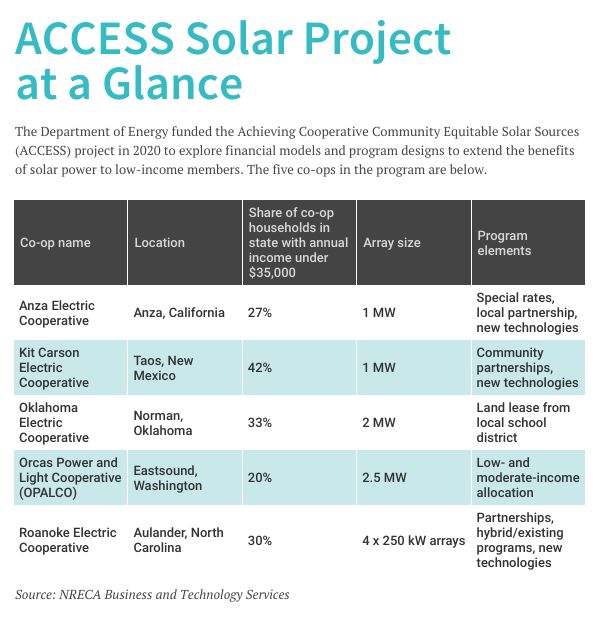A $1.2 million, multiyear NRECA project researching the best ways for electric cooperatives to extend the benefits of solar power to lower-income members is wrapping up at the end of this year.
The Department of Energy funded the
Achieving Cooperative Community Equitable Solar Sources (ACCESS) project in 2020 to explore financial models and program designs for community solar through projects based at five co-ops.
The ACCESS project is the flagship effort of NRECA’s
Advancing Energy Access for All initiative, which spotlights co-ops’ efforts to ensure that grid advancements benefit everyone.
“The goal of ACCESS is to identify what works and what doesn’t in helping ensure that the benefits of the energy transition are accessible to every member,” said Lisa Slaughter, ACCESS principal investigator for NRECA.
[section]
[section-item]
[row]
[column 12]

[/column]
[/row]
[/section-item]
[/section]
The participating co-ops are
Anza Electric Cooperative in Anza, California;
Kit Carson Electric Cooperative in Taos, New Mexico;
Oklahoma Electric Cooperative in Norman;
Orcas Power and Light in Eastsound, Washington; and
Roanoke Electric Cooperative in Aulander, North Carolina.
“Instead of pushing a one-size-fits-all strategy, ACCESS supported co-ops in designing projects that are responsive to the unique communities they serve, maximizing the benefits and ensuring good alignment with community needs,” Slaughter said.
Supply chain issues during the COVID-19 pandemic led to some project delays, said Slaughter, noting that two co-ops completed their projects, while the others are nearly finished.
“Everyone had to take a step back and rethink their portfolio and where their efforts were going because efforts became very constrained,” said Slaughter.
In Oklahoma, pandemic-related school closures and supply chain constraints forced OEC to postpone the educational component of its project, a 15-acre, 2-megawatt solar farm built on land leased from Norman Public Schools, where about half of the district’s students qualify for free or reduced-price meals.
But school and co-op officials are still committed to the solar education center, which is likely to start construction soon, said Nick Shumaker, OEC’s manager of systems engineering.
“We met with the teachers. We've gotten an architect, and we have a 3D model built, and [last month], the superintendent and our CEO approved of the project. So now we're moving forward with getting partners and getting it funded.”
Despite the setbacks, Slaughter said ACCESS projects have resulted in positive outcomes for co-ops and their members, including savings of 20% to 100% for some participants, strong community partnerships and protection against blackouts and price volatility during extreme weather events.
Final case studies will be available on the ACCESS section of cooperative.com in January. Other resources will include a financial calculator to help co-ops assess costs and a battery performance testing guide for co-ops considering solar battery storage, as well as information on related programs, such as the federal Low-Income Home Energy Assistance Program.
While the ACCESS project is ending, NRECA is committed to continuing its mission, Slaughter said. For example, NRECA is working with the Sandia, Pacific Northwest, and Lawrence-Berkeley National Laboratories to explore programs and technologies that can reduce the impacts of power outages on low-income communities.
“It’s an unprecedented time in the energy business, when change is moving fast,” Slaughter said. “Co-ops are doing a lot to ensure the advancements are accessible to all of their members. Collaborations like ACCESS allow us to provide tools that support them in those efforts.”
